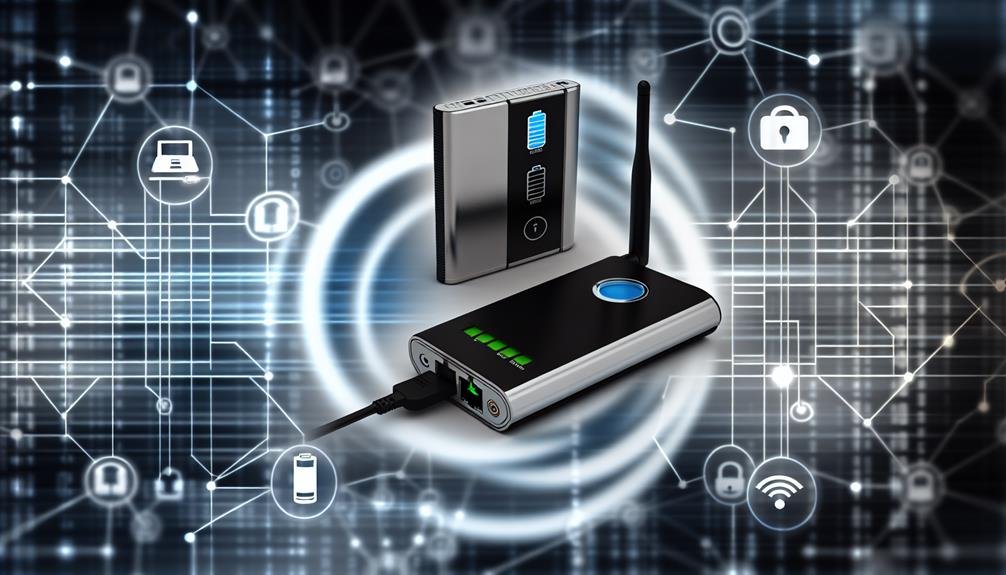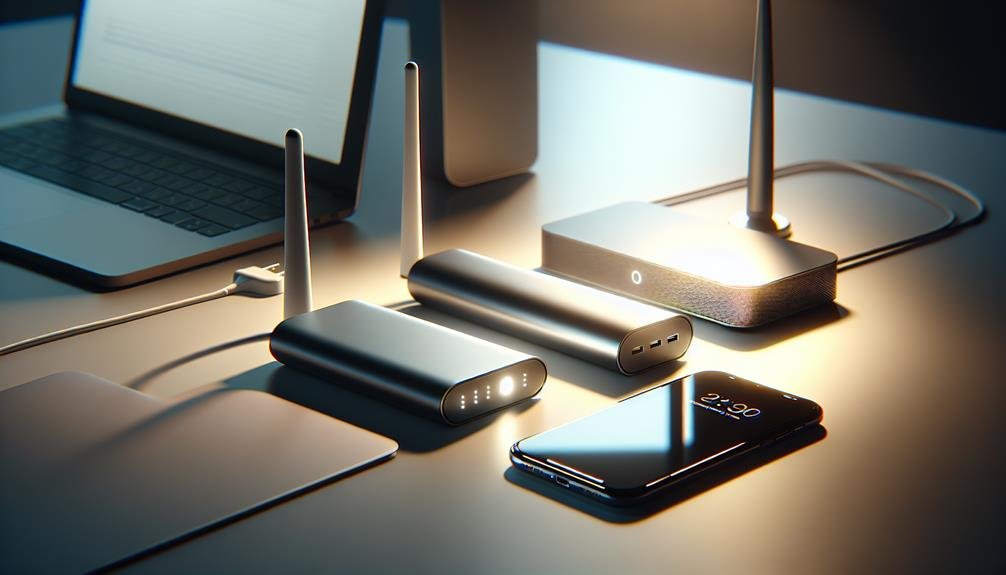Yes, a power bank can power your router if it meets the necessary voltage and amperage requirements. First, check your router's label for its voltage and current needs. Confirm your power bank has the appropriate output and compatible connectors. Calculate wattage by multiplying the voltage and current. Use a stable, well-managed setup to prevent disconnections. Higher capacity power banks can provide longer operational times. Adopting proper battery maintenance habits can enhance both performance and longevity. Understanding these details helps guarantee seamless internet connectivity during power outages—keep learning to discover more techniques for efficient power usage.
Understanding Power Bank Capacity

Understanding power bank capacity is important because it directly determines how long you can power your router without an external power source. The battery capacity, usually measured in milliampere-hours (mAh), indicates the total charge the power bank can store. Higher capacity means longer operational time for your router.
When choosing a power bank, consider the charging speed. Power banks with higher output currents can charge devices faster, but you need to make sure they're compatible with your router's power requirements. Most routers operate on specific voltage outputs, typically 5V to 12V. Making sure your power bank can deliver the correct voltage is vital for safe and efficient operation.
Device compatibility is another key factor. Not all power banks are universally compatible with every router. Check the power bank's specifications to verify it matches your router's voltage and current requirements. Some power banks come with multiple output ports, offering different voltages and currents to accommodate various devices. Selecting a power bank that aligns with your router's needs ensures a stable power supply and reduces the risk of damage.
Router Power Requirements
To secure your router operates smoothly with a power bank, you need to pinpoint its specific power requirements, including voltage, current, and wattage. First, check the router's label or user manual for its voltage rating, typically between 9V to 12V. This parameter is essential because mismatched voltage could damage the router or the power bank. Next, identify the current requirement, usually denoted in amperes (A). Most home routers draw between 0.5A to 2A, and this affects the overall router power consumption.
Now, calculate the wattage by multiplying voltage (V) by current (A). For instance, a 12V router drawing 1A will consume 12 watts. Understanding this helps you match the router's power needs with the power bank capacity. When selecting a power bank, its capacity, measured in milliampere-hours (mAh), should be adequate to sustain the router for the desired duration. For example, a 10,000mAh power bank could theoretically run a 12W router for approximately 8 hours, considering efficiency losses.
Make sure that the power bank's output voltage and current ratings meet or exceed the router's requirements. This careful alignment will secure safe and efficient operation, protecting both your devices and maintaining a stable internet connection.
Compatibility Check

Once you've determined the router's power requirements, it's important to make sure that the power bank you choose is compatible with voltage, current output, and connector type. Confirming this compatibility is key to both the performance and safety of your devices. Here's what to keep in mind:
- Voltage requirements: Verify that the voltage output of the power bank matches the router's voltage needs. Most routers require 9V to 12V, while many power banks provide 5V or 12V outputs. Mismatched voltages can harm your router or make the power bank ineffective.
- Power bank capabilities: Evaluate the power bank's current output capabilities. Routers typically need between 1A to 2A. Check that the power bank can supply enough amperage to prevent overloading and potential overheating. This guarantees stable operation without pushing the power bank's limits.
- Connector type: Confirm that the connectors on the power bank are suitable for your router. Some power banks come with multiple adapter tips or USB ports, but ensure they fit securely to avoid loose connections which can result in interruptions or damage.
Connecting a Power Bank
Frequently, connecting a power bank to your router involves using the appropriate adapter and securing a snug fit to maintain a stable power supply. First, confirm that the adapter's voltage and current ratings match your router's requirements. Incorrect ratings can lead to instability or even damage.
Next, consider power bank placement and router positioning. Place the power bank on a stable, level surface near the router to minimize cable strain and enhance connection stability. Proper cable management is essential to avoid tangling and potential disconnections. Use cable clips or ties to keep the area organized.
Here's a quick guide to help visualize the setup:
| Step | Action | Notes |
|---|---|---|
| 1. Adapter Check | Verify voltage/current compatibility | Refer to router manual |
| 2. Secure Fit | Connect adapter to router and power bank | Ensure connections are secure |
| 3. Power Bank Placement | Place on stable surface | Prevents accidental movement |
| 4. Router Positioning | Position near power bank | Minimizes cable length |
| 5. Cable Management | Use clips/ties for organization | Reduces risk of disconnection |
Battery Life Expectations

Understanding battery life expectations is essential for guaranteeing your power bank can reliably sustain your router during power outages or travel. To achieve peak performance, you need to take into account several variables, including your power bank's capacity, the router's power consumption, and your charging habits.
Battery life and performance expectations can vary significantly based on usage patterns. For example, a 20,000mAh power bank might last longer if you're only using the router intermittently compared to continuous use. Monitoring your router's wattage requirements will help you make precise calculations of battery life.
To maximize efficiency and safety, take into consideration the following:
- Capacity Matching: Guarantee your power bank's capacity aligns with your router's power needs. A higher mAh rating generally means longer battery life.
- Charging Cycles: Understand that frequent charging and discharging cycles can degrade battery performance over time. Adopting ideal charging habits can prolong battery life.
- Usage Patterns: Regularly assess how and when you use your router. Continuous heavy usage will drain the power bank faster than sporadic, light usage.
Benefits of Using a Power Bank
You'll find power banks offer significant benefits, such as portability and convenience, making them ideal for on-the-go usage. Additionally, they serve as a reliable emergency power source during outages, ensuring uninterrupted router operation. These advantages highlight the practical utility of integrating power banks with routers.
Portability and Convenience
One of the primary benefits of using a power bank to power your router is the enhanced portability it provides, guaranteeing continuous internet access even during power outages or while traveling. You won't have to worry about disruptions in your internet connection, which is essential for both work and leisure activities. Power banks are designed to be compact and lightweight, making them easy to carry and store.
When it comes to charging efficiency, modern power banks are highly optimized, providing a stable and consistent power output to keep your router running smoothly. This ensures that the router functions at its peak performance without fluctuations that could disrupt your internet service. Additionally, some power banks offer wireless charging capabilities, which can add another layer of convenience. You can place your compatible router on the power bank without the need for tangled cables, keeping your space neat and organized.
- Seamless internet connectivity: Guarantees you stay connected even during power outages.
- Compact design: Easy to transport and store, ideal for travel.
- Stable power output: Maintains router performance without fluctuations.
Emergency Power Source
In addition to portability and convenience, a power bank serves as a reliable emergency power source, guaranteeing your router remains operational during unexpected power outages. During emergency situations, maintaining internet connectivity can be vital for accessing real-time updates, communication, and coordination. By using a power bank, you can provide your router with the necessary backup power to keep your network running smoothly.
Power banks are designed for portable charging, making them an ideal solution for emergencies. They can be easily stored and quickly deployed to power your router and other essential electronic devices. When selecting a power bank for emergency use, consider its capacity (measured in mAh) to guarantee it can supply adequate power to your router for an extended period. Additionally, check the power bank's output voltage and current specifications to match your router's requirements.
Ensuring safety during power outages is paramount. A power bank offers a stable and controlled power source, reducing the risk of damage to your router and other connected devices. By integrating a power bank into your emergency preparedness plan, you can maintain connectivity and enhance your safety during critical times.
Potential Limitations

Despite the convenience of using a power bank to power a router, there are several potential limitations you need to keep in mind for uninterrupted connectivity and peak performance. First, power bank limitations and compatibility issues can arise. Not all power banks are designed to deliver the stable output needed by your router. Variations in voltage and amperage could lead to inconsistent performance or even equipment damage.
Second, router power consumption and performance concerns are crucial. Routers typically require a continuous and stable power supply to maintain the best functionality. A power bank with insufficient capacity or output may cause your router to underperform, resulting in slower internet speeds or intermittent connectivity.
Consider these potential limitations:
- Power Bank Limitations: Ensure your power bank's output matches your router's power requirements.
- Compatibility Issues: Verify that the power bank and router are compatible to avoid damage or performance dips.
- Router Power Consumption: Calculate your router's power draw to make sure the power bank can sustain it for the desired duration.
Safety Precautions
When powering your router with a power bank, you must guarantee correct voltage compatibility to avoid damage. Additionally, implement overheating prevention measures to safeguard both the power bank and router. Regular battery maintenance tips will help prolong the lifespan and efficiency of your power bank.
Correct Voltage Compatibility
Checking that your power bank and router have compatible voltage ratings is essential to prevent potential damage and guarantee safe operation. Voltage regulation is a pivotal factor here. Power banks often have voltage limitations, typically outputting 5V, 9V, or 12V, while routers usually require a specific voltage to function correctly. Ensuring that these voltages match is paramount for maintaining the integrity and performance of your devices.
Router power consumption varies depending on the make and model, so you must verify the router's voltage requirements against your power bank's output. Failing to do so could result in insufficient power delivery, rendering your router inoperable, or worse, causing permanent damage.
Consider the following safety precautions:
- Check Router Specifications: Consult your router's user manual or technical specifications to confirm the required voltage and current ratings.
- Power Bank Capabilities: Verify that your power bank can deliver the necessary voltage consistently and safely without exceeding its limitations.
- Voltage Adaptors: If the voltage ratings do not align, consider using a voltage adaptor to regulate the output from the power bank to match your router's requirements.
Overheating Prevention Measures
To prevent overheating when powering your router with a power bank, it's essential to guarantee proper ventilation and monitor the device's temperature regularly. Establishing an effective ventilation design is vital. Position the router and power bank in a well-ventilated area, avoiding enclosed spaces where heat can accumulate.
Incorporating a cooling fan can greatly enhance heat dissipation. Place a small, USB-powered cooling fan near the router to circulate air and reduce temperature. This is particularly useful when running the router for extended periods.
Thermal paste application, while more common in high-end computing, can also be used to improve heat transfer between critical components inside the router. If you're comfortable opening the device, apply thermal paste between the CPU and its heat sink to ensure efficient heat dissipation.
Regularly monitor the surface temperature of both the router and the power bank. An infrared thermometer can provide quick, accurate readings. If either device becomes excessively hot, disconnect them immediately and allow them to cool down before resuming operation.
Battery Maintenance Tips
Proper battery maintenance is important for ensuring the longevity and safety of your power bank when used to power a router. By following key safety precautions, you can maintain battery health and optimize charging cycles.
First, always consider the power bank selection and perform a thorough capacity evaluation before use. Choose a power bank with sufficient capacity to support your router's power requirements without frequent recharges, as frequent charging cycles can degrade battery health over time.
Next, monitor the charging cycles carefully. Avoid overcharging or completely depleting your power bank's battery, as this can negatively impact its lifespan and efficiency. Aim to maintain a charge level between 20% and 80% to enhance longevity.
Lastly, store your power bank in a cool, dry place. Extreme temperatures can damage the battery and reduce its overall performance. Make sure to keep it away from direct sunlight and high humidity environments.
Here are some key maintenance tips:
- Avoid Overcharging: Disconnect the charger once the power bank is fully charged.
- Regular Usage: Use the power bank periodically to keep the battery active.
- Check for Damage: Inspect the power bank for any signs of wear or damage before each use.
Alternative Power Solutions

Exploring other power solutions, you'll find that using a power bank to operate a router can offer a reliable and portable backup during power outages or when you're on the move. However, there are other options like solar panels and wind turbines that can complement or even replace a power bank.
Solar panels convert sunlight into electricity, providing a sustainable and renewable energy source. By connecting a solar panel system to a battery bank, you can store energy during the day and use it to power your router at any time. This setup guarantees continuous internet connectivity without relying on traditional power sources, making it ideal for remote areas.
Wind turbines, another renewable choice, harness wind energy to generate electricity. Small-scale wind turbines can be installed at home, generating power that can be stored in batteries. This stored energy can then be used to operate your router, offering a stable and eco-friendly solution.
When considering safety, it's essential to use high-quality components and adhere to installation guidelines. Properly maintained systems reduce risks of malfunctions or hazards. Whether you choose a power bank, solar panels, or wind turbines, these other power solutions can ensure uninterrupted connectivity in a safe and efficient manner.
Frequently Asked Questions
Can Using a Power Bank Void My Router's Warranty?
Using a power bank might void your router's warranty due to power bank compatibility issues. Mismatched voltage output can harm router performance. Check warranty concerns and guarantee voltage output compatibility for safety and best router performance.
Are There Specific Brands of Power Banks That Are Recommended for Routers?
Around 60% of users report improved performance with compatible power banks. For router power supply, look for brands like Anker or RAVPower. Confirm compatibility with your router's voltage and current requirements for best safety.
How Does Ambient Temperature Affect Power Bank Performance With a Router?
You're asking about ambient temperature's effect on power bank efficiency with a router. Extreme temperatures, both hot and cold, can reduce power bank performance to a large extent, potentially causing overheating or reduced battery life, impacting overall safety and reliability.
Can a Power Bank Connect to Multiple Devices Simultaneously, Including a Router?
You'll need to check the power bank's compatibility with multiple devices for simultaneous charging, including a router. Guarantee it has enough output ports and power capacity to safely support all connected devices without overloading.
Is It Safe to Use a Power Bank While It Is Charging?
Using a power bank while charging's like walking a tightrope. It's not ideal due to battery life concerns and overheating risks. Charging speed and compatibility can also be affected, leading to potential safety hazards.



